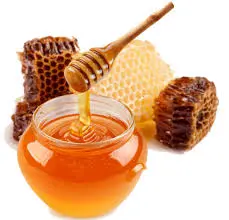Can a Dog Eat Honey? A Comprehensive Guide to Understand the Benefits and Risks
As a dog owner, which human foods are safe to share with your furry friend. One common food that frequently comes up in discussions is honey. Known for its natural sweetness and numerous health benefits for humans, you might be curious: can a dog eat honey? In this article, we will explore the safety, potential benefits, and risks of feeding honey to dogs, allowing you to make an informed decision for your pet.
What is Honey?
Honey is a natural sweet substance produced by bees from the nectar of flowers. It has been used for centuries as a food and a remedy due to its potential health benefits. Honey is rich in antioxidants, vitamins, and minerals, making it a popular choice for many health-conscious individuals. However, when it comes to dogs, it’s essential to consider how honey affects their health.

Can Dogs Eat Honey?
The answer is generally yes, dogs can eat honey, but moderation is crucial. While honey is not toxic to dogs, it is important to understand the implications of adding it to their diet.
1. Nutritional Benefits
Honey contains several nutrients that can be beneficial for dogs:
- Antioxidants: Honey is rich in antioxidants, which can help fight free radicals and reduce inflammation. This can be particularly helpful for older dogs or those with certain health issues.
- Vitamins and Minerals: Honey provides small amounts of essential vitamins and minerals, such as vitamin C, calcium, and magnesium. These nutrients can contribute to overall health.
- Energy Boost: The natural sugars found in honey can provide a quick energy boost for active dogs, making it a great option for a post-exercise treat.
2. Natural Remedy
Honey has been known to have antimicrobial properties and may aid in healing wounds. Some dog owners use honey topically for minor cuts and abrasions. Additionally, honey can soothe a dog’s throat if they are experiencing mild coughing. However, it’s always best to consult your veterinarian before using honey as a remedy for health issues.
Risks of Feeding Honey to Dogs
Despite the benefits, there are some risks to consider before sharing honey with your dog:
1. High Sugar Content
Honey is primarily composed of sugar. Feeding your dog too much honey can lead to several health issues, including:
- Weight Gain: Excessive sugar intake can contribute to obesity in dogs. Maintaining a healthy weight is essential for preventing various health problems.
- Dental Issues: Sugary foods can lead to dental problems, such as cavities and gum disease. Regular dental care is crucial for your dog’s overall health.
2. Potential for Allergies
Just like humans, dogs can have allergic reactions to honey. While rare, symptoms can include itching, swelling, or gastrointestinal upset. If you are introducing honey to your dog’s diet for the first time, monitor them closely for any adverse reactions.
3. Not Suitable for Puppies
Puppies under one year old should not be fed honey. Their immune systems are still developing, and honey can contain spores of Clostridium botulinum, a bacterium that can cause botulism in young dogs. It’s crucial to wait until your puppy is at least a year old before introducing honey to their diet.
How to Safely Introduce Honey to Your Dog
If you decide to share honey with your dog, follow these guidelines to ensure it’s safe:
1. Start Small
Begin with a tiny amount of honey—perhaps half a teaspoon—to see how your dog reacts. If they show no signs of discomfort or allergic reaction, you can gradually increase the amount.
2. Choose Raw, Organic Honey
Opt for raw, organic honey whenever possible. Raw honey contains more nutrients and beneficial compounds than processed varieties, which may have added sugars or preservatives.
3. Use Honey as a Treat
Instead of incorporating honey into your dog’s regular diet, consider using it as an occasional treat or a topping for their food. This helps keep the sugar intake within a reasonable range.
4. Consult Your Veterinarian
Before adding any new food to your dog’s diet, it’s always a good idea to consult your veterinarian. They can provide personalized advice based on your dog’s health, size, and dietary needs.
Homemade Dog Treats with Honey
If you want to treat your dog to something special that includes honey, consider making homemade dog treats. Here’s a simple recipe:
Peanut Butter and Honey Dog Biscuits
Ingredients:
- 1 cup whole wheat flour
- 1/2 cup rolled oats
- 1/4 cup peanut butter (xylitol-free)
- 1/4 cup honey
- 1/4 cup water (as needed)
Instructions:
- Preheat your oven to 350°F (175°C).
- In a mixing bowl, combine the whole wheat flour and rolled oats.
- Add the peanut butter and honey, mixing until well combined. If the mixture is too dry, add water gradually until the dough is workable.
- Roll the dough out on a floured surface and cut into shapes using cookie cutters.
- Place the biscuits on a baking sheet lined with parchment paper and bake for 20-25 minutes or until golden brown.
- Allow the treats to cool completely before giving them to your dog.
These homemade treats not only provide a tasty snack but also allow you to control the ingredients, ensuring they are safe for your furry friend.
Conclusion
In conclusion, honey can be a safe and healthy treat for dogs when given in moderation. It offers various benefits, including nutritional value and potential health improvements, but it is crucial to be mindful of the risks associated with excessive sugar intake and the age of your dog. Always introduce honey gradually and observe your dog for any adverse reactions.
If you’re ever in doubt about whether a specific food is safe for your dog, don’t hesitate to consult your veterinarian. By making informed decisions about your dog’s diet, you can help ensure they live a happy and healthy life, occasionally enjoying sweet treats like honey! can dog eat jelly?
